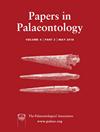北格陵兰晚奥陶世和早志留纪病毒腕足动物和腕足动物:对暖水动物群落的影响
IF 2.2
2区 地球科学
Q1 PALEONTOLOGY
引用次数: 0
摘要
这里首次系统地描述了北格陵兰奥陶纪-志留纪界线区间(晚加氏-阿龙纪)的一套异常丰富和多样的病毒腕足类,这些病毒腕足类迄今所知甚少。晚奥陶世的蛭形类包括暖水蛭形类动物群的典型类群(如 Tcherskidium tenuicostatum、Proconchidium schleyi、Holorhynchus giganteus 和 Deloprosopus dawesi sp.)在志留纪早期的类群中,Virgiana hursti sp.nov.作为丰富的贝床出现,与劳伦提亚的其他同属物种相似,但其内部骨架结构更大一些,尽管不像晚卡蒂期的 virgianids 那样发达;Borealoides balderi gen. et sp.nov.的壳壁和内部结构极度增厚,接近卡蒂期 virgianids 的极度钙化。在北格陵兰岛也出现了非常独特的中生代腕足动物 Kulumbella 属,其特征是贝壳上有纵横交错的棱纹(divaricate),以 K. heimdali sp.从古地理学角度来看,劳伦西亚的晚奥陶世病毒虫动物群非常独特,仅限于古赤道以北的中低热带纬度地区。相比之下,早志留纪(Rhuddanian)的维吉亚纳类和劳伦西亚的一些相关类群跨越了两个半球的热带地区,在碳酸盐盆地中形成了广泛的贝床,尽管Borealis和Borealoides gen.古生态学上对暖水碳酸盐环境的偏好可以解释北格陵兰地区异常丰富的病毒虫动物群。本文章由计算机程序翻译,如有差异,请以英文原文为准。
Late Ordovician and early Silurian virgianid and stricklandioid brachiopods from North Greenland: implications for a warm-water faunal province
An unusually rich and diverse suite of virgianid brachiopods, hitherto poorly known, is systematically described here for the first time from the Ordovician–Silurian boundary interval (late Katian – Aeronian) of North Greenland. The Late Ordovician virgianids comprise typical taxa of the warm-water Tcherskidium fauna (e.g. Tcherskidium tenuicostatum, Proconchidium schleyi, Holorhynchus giganteus and Deloprosopus dawesi sp. nov.). Among the early Silurian taxa, Virgiana hursti sp. nov. occurs as abundant shell beds, similar to other congeneric species in Laurentia, but has somewhat larger internal skeletal structures, albeit not as extravagantly developed as in the late Katian virgianids; Borealoides balderi gen. et sp. nov. shows extreme thickening of the shell wall and internal structures, approaching the extravagant calcification of Katian virgianids. The highly distinctive mid-Aeronian stricklandioid brachiopod genus, Kulumbella, characterized by a shell with criss-cross (divaricate) ribbing, also occurs in North Greenland, represented by K. heimdali sp. nov., which has the largest and most strongly biconvex shells for the genus. Palaeogeographically, the Late Ordovician virgianid fauna of Laurentia was highly distinct, confined to the low–mid tropical latitudes north of the palaeoequator. In comparison, the early Silurian (Rhuddanian) Virgiana and some related taxa in Laurentia spanned the tropics of both hemispheres, forming extensive shell beds in carbonate basins, although Borealis and Borealoides gen. nov. remained confined largely to the northern hemisphere, suggesting a certain level of provincialism extending into the earliest Silurian. A palaeoecological preference for warm-water carbonate settings would explain the unusual abundance and richness of the virgianid faunas in North Greenland.
求助全文
通过发布文献求助,成功后即可免费获取论文全文。
去求助
来源期刊

Papers in Palaeontology
PALEONTOLOGY-
CiteScore
4.50
自引率
4.30%
发文量
55
期刊介绍:
Papers in Palaeontology is the successor to Special Papers in Palaeontology and a journal of the Palaeontological Association (www.palass.org). The journal is devoted to the publication of papers that document the diversity of past life and its distribution in time and space.
Papers in Palaeontology is devoted to the publication of papers that document the diversity of past life and its distribution in time and space. As a sister publication to Palaeontology its focus is on descriptive research, including the descriptions of new taxa, systematic revisions of higher taxa, detailed biostratigraphical and biogeographical documentation, and descriptions of floras and faunas from specific localities or regions. Most contributions are expected to be less than 30 pp long but longer contributions will be considered if the material merits it, including single topic parts.
The journal publishes a wide variety of papers on palaeontological topics covering:
palaeozoology,
palaeobotany,
systematic studies,
palaeoecology,
micropalaeontology,
palaeobiogeography,
functional morphology,
stratigraphy,
taxonomy,
taphonomy,
palaeoenvironmental reconstruction,
palaeoclimate analysis,
biomineralization studies.
 求助内容:
求助内容: 应助结果提醒方式:
应助结果提醒方式:


